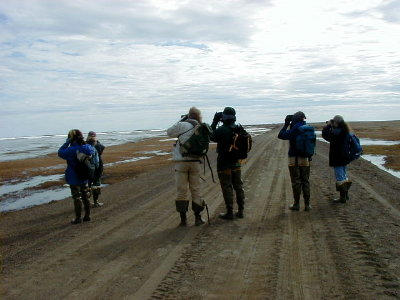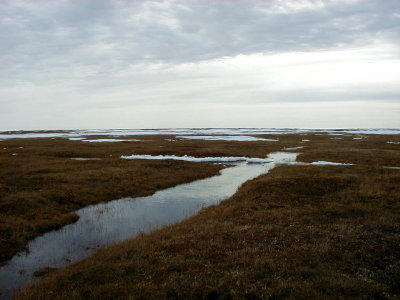16 June, 1999
June 16th, 1999 - Walking on Tundra...
Hello all! Today I had my first real taste of what wildlife research in
the arctic is like. The temperature dipped down a bit (in the 30's) and it
was very windy! The Steller's Eider crew (we number 9 now) broke down into
teams of 2 and began surveys on foot of the tundra. Philip Martin, a
biologist for USFWS (United States Fish and Wildlife Service) and I
traveled for a few miles (it felt like MANY miles) around frozen lakes and
through snow and puddles, over the ground that is broken into polygons.
The tundra is like mud puddles when they dry up and contract, and form
polygon shapes. Between the polygon shapes of land is water of various
depths that will refreeze when winter comes. It forms ice wedges that grow
larger and deeper with each passing winter.
We used aerial maps to orient ourselves and plot locations of any
Steller's Eiders that we saw. We tromped around outside from 11am until
6pm, when we had to go pick up the last 2 members of the team from USFWS at
the airport. We are now full force! There are probably more of us (9),
then there are Steller's Eiders. Well, that is not QUITE true, but it felt
like it today. Of the 3 teams that went out to survey different areas,
each of us found 3 pairs of Steller's Eiders. Sometimes, it is difficult
to tell if it is the same pair just moving around !
I also have developed blisters on the back of my heels from my
hipwaders which are still too big. I have put felt insoles in them, and
wear 2 pairs of wool socks. Kara Weller, a seasonal employee of USFWS, was
kind enough to give me some moleskin to put over my blisters. Not that I
am whining, now! I realize I have the habit of giving very little sympathy
to my friends, and I know people who are reading this are now thinking of
what I say to them when they complain: " Suck it up!"
I am working hard to attach photos to this journal entry, but may
need to enlist help in the morning, so sorry for any delay.
By the way, it is 1:42 am right now, and as bright as the middle of
the day was today. It is just now starting to feel more normal to go to
sleep when it is so bright outside. Hope everyone is doing well, and thank
you to everyone who responded to me today - it was so nice to get mail!
Aloha to Wai'anae High School, if you were able to get over your own
internet troubles!
Michele Hauschulz

A common site on the tundra: all of us with binoculars to our eyes: "Wher= e are those Steller's Eiders, anyway?" ____________________________________________________________________ Get your own FREE, personal Netscape WebMail account today at http://webm= ail.netscape.com.

Tim Obretschkewitsch and Kara Weller, both from USFWS (United States Fish= eries and Wildlife Service) piece together aerial maps that we will use to orie= nt ourselves in the field. ____________________________________________________________________ Get your own FREE, personal Netscape WebMail account today at http://webm= ail.netscape.com.

In spring, meltwater fills the cracks in the tundra. In winter, this wil= l later freeze and add to the size of the vertical ice wedge in the ground.= ____________________________________________________________________ Get your own FREE, personal Netscape WebMail account today at http://webm= ail.netscape.com.
Contact the TEA in the field at
.
If you cannot connect through your browser, copy the
TEA's e-mail address in the "To:" line of
your favorite e-mail package.
|
